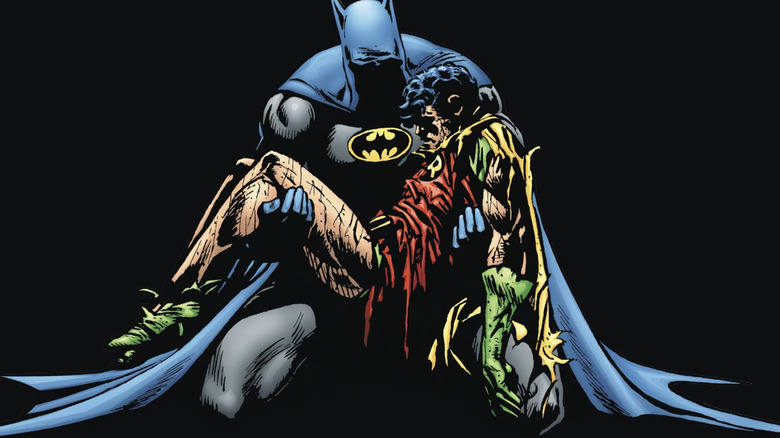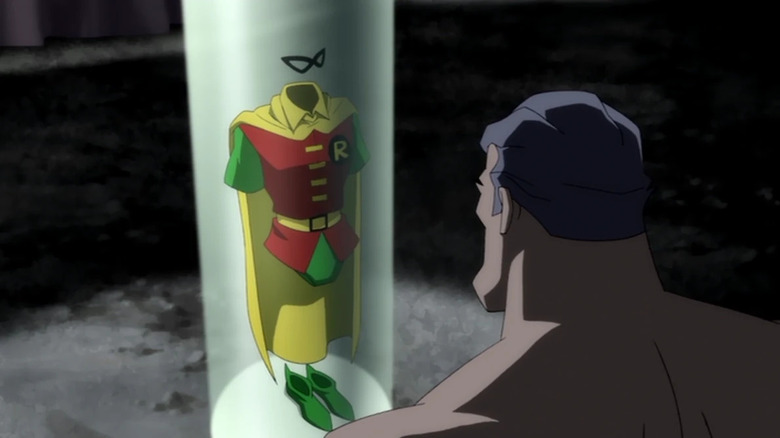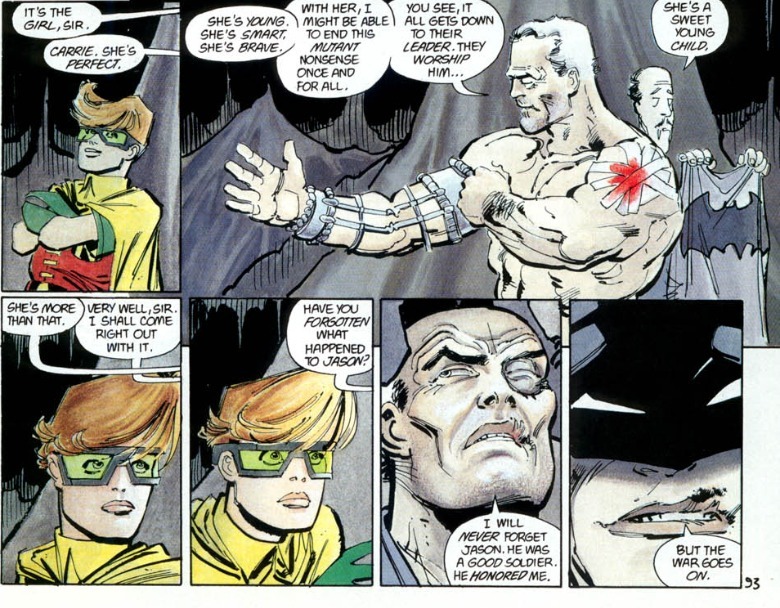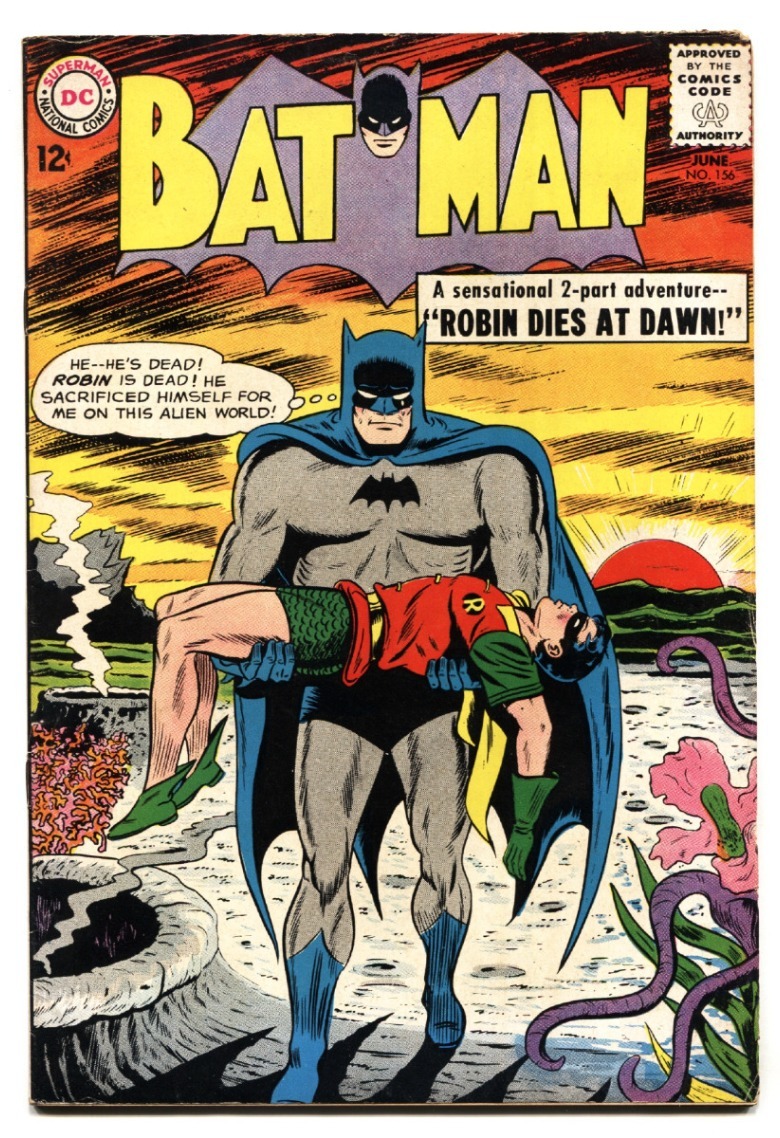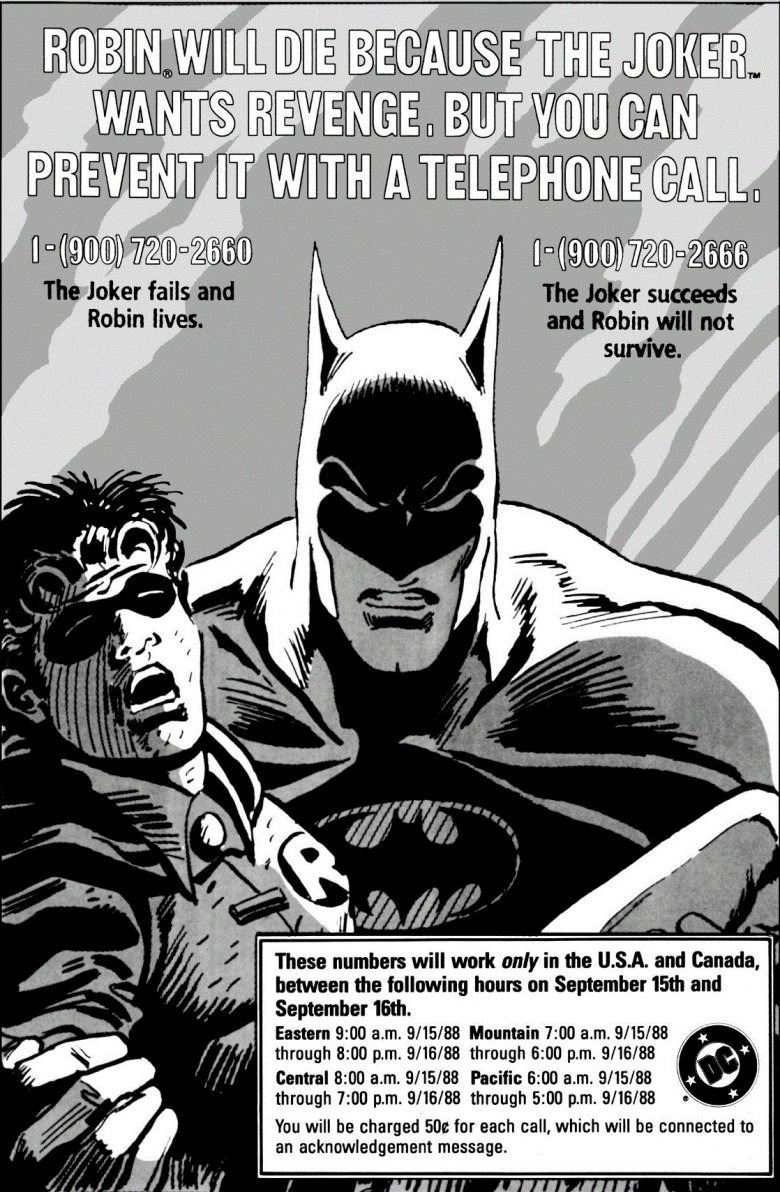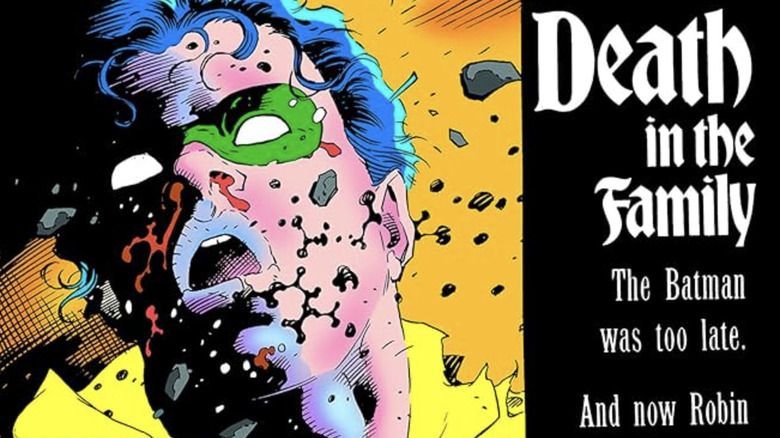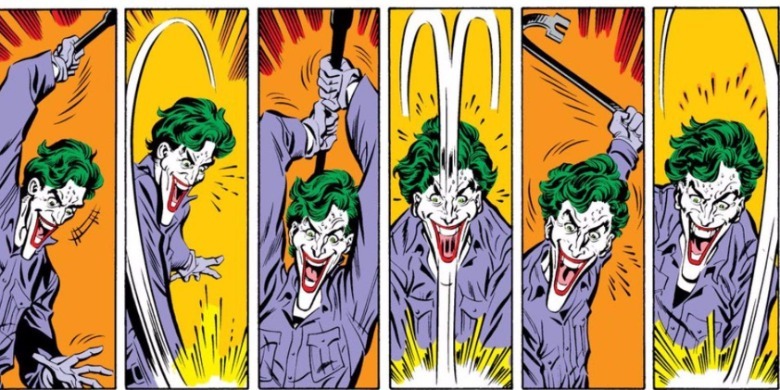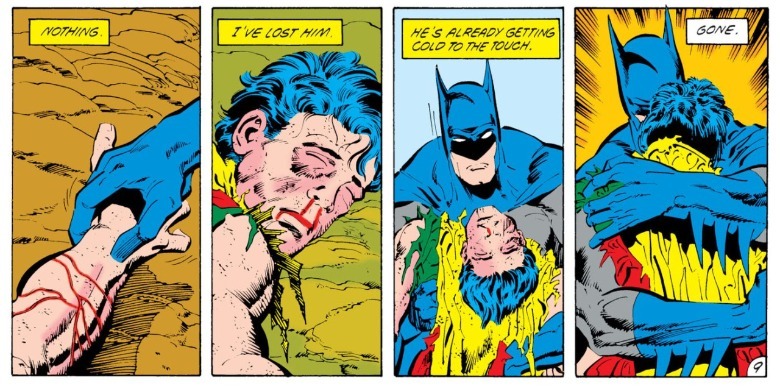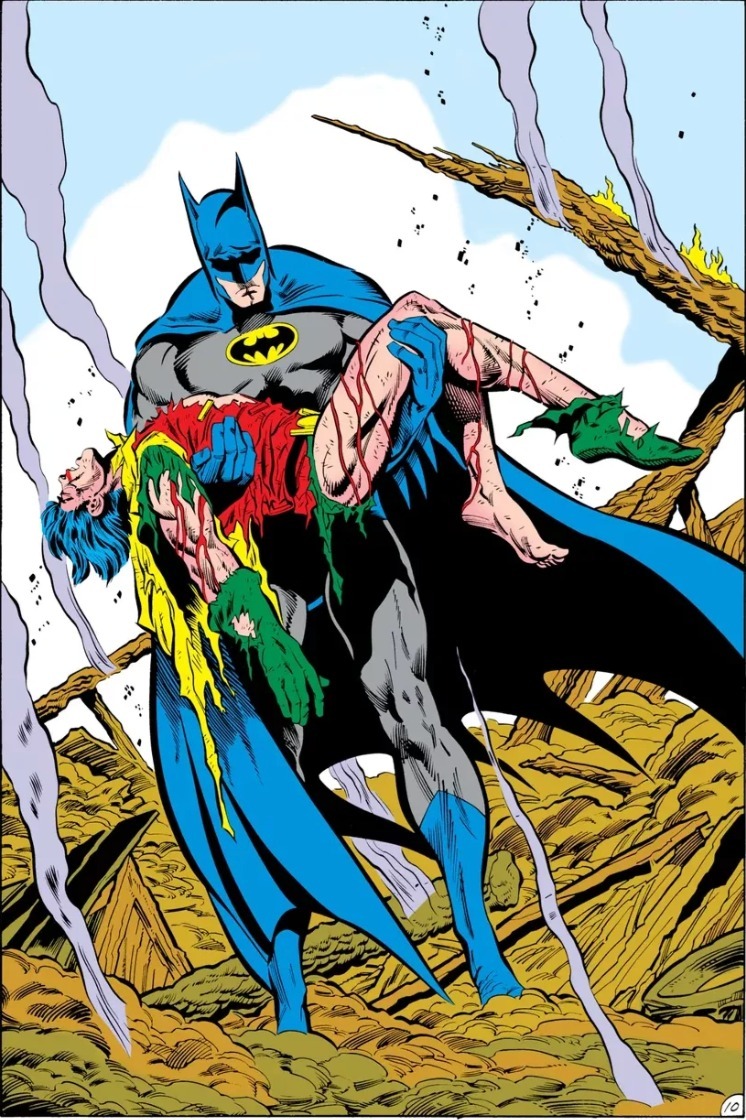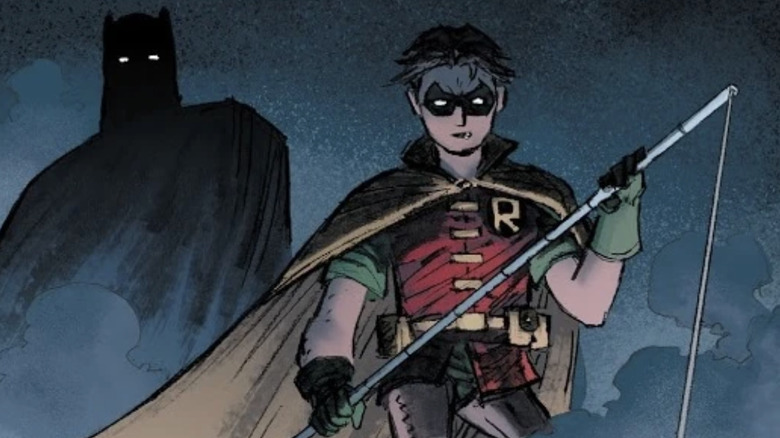The Dark Knight Returns Predicted The Death Of Robin In Batman Comics
The late 1980s were a watershed moment for Batman comics, when the character truly became the Dark Knight thanks to writer/artist Frank Miller. Miller's "The Dark Knight Returns," published across four issues in 1986, reimagined Batman from a detective adventurer into basically Clint Eastwood's Dirty Harry Callahan character draped in a cape and cowl.
In "Returns," a 55-year-old Bruce Wayne (no longer Batman) has spent 10 years trying to find either a new reason to live or a good death, and failed. Gotham City is stuck in a wave of gang violence, so to stop that and his own inner turmoil, Bruce becomes Batman again. As much a political satire as a superhero book, Batman finds the world of 1986 may not be a friendly environment for him, which is a narrative representation of Miller's fundamental question: What purpose does Batman serve 50 years after his creation?
Miller's "Dark Knight" was probably the most important Batman comic published since the days of "Detective Comics" writer/artist duo Denny O'Neill and Neal Adams, if not those of Batman's primary creator Bill Finger and co-creator Bob Kane. The next year, Miller and David Mazzucchelli put out "Batman: Year One"; Miller had already told Batman's last adventure, now he'd tell the character's first. Tim Burton's darker silver screen Batman happened thanks to "The Dark Knight Returns." Even today, Batman writers like Scott Snyder (penning the new "Absolute Batman" comic series) cite "The Dark Knight Returns" as their chief influence.
One of Miller's early imitators was Jim Starlin, who is mostly known for creating Thanos over at Marvel Comics. Starlin took over as the primary Batman writer on issue #414 and built up his run to "A Death in the Family," the infamous story where the Joker murders Jason Todd, the second Robin.
In "The Dark Knight Returns," it's all but said that Bruce first quit being Batman after Jason died in the line of duty. When I was younger and didn't have the dates in mind, I'd assumed that of course "The Dark Knight Returns" included this backstory to build off of "A Death in the Family." But nope, it was actually the other way around.
How Jason Todd died in Batman comics
"The Dark Knight Returns" does not specify what happened to Jason, exactly, but you don't have to read too deeply within the lines. In one of the comic's first scenes, Bruce is having a drink with Commissioner Gordon (who now knows the former Batman's secret). When Gordon laments "what happened to Jason," Bruce leaves. He later thinks to himself of how he promised Jason "never again." During one of Bruce's sleepwalking episodes (driven by his urge to be Batman), he comes to in the Batcave, looking at the case holding Jason's Robin suit; a memorial to a fallen soldier.
Finally, in issue #2 ("The Dark Knight Triumphant"), when Bruce considers taking in the young Carrie Kelley as his new Robin, Alfred again reminds him of Jason's fate.
When Miller created "The Dark Knight Returns, Jason was Robin in the mainstream Batman comics, the kind still targeted at children. Before 1986, Robin dying was something that could only happen on fake-out covers:
The suggestion that Boy Wonder had truly been killed in the line of duty was there to show how different this take on Batman was from the norm. But no doubt because of how acclaimed and instantly influential "The Dark Knight Returns" was, the idea stuck in DC Comics' craw. Look at this excerpt from "Detective Comics" #571 (by Mike Barr and Alan Davis), published during the thin window between "The Dark Knight Returns" and "A Death in the Family."
Moreover, Jason Todd was not a popular character. There was innate resentment from readers who preferred Robin I/Dick Grayson, and to distinguish him from Dick, Jason was also written as a more abrasive, punk-ish Robin. (Jason's revised origin story? Batman caught him stealing the Batmobile's tires and decided to save him from a bad path.) This wound up only making him even more unpopular next to Dick.
Starlin also disliked Robin in general, preferring Batman as a solo act since, as he once told UniversoHQ, "the idea of taking a kid along to fight crime is ludicrous." Starlin pushed to kill Robin off and eventually got his wish. He chose the Joker as the killer explicitly because of "The Dark Knight Returns" — Frank Miller's intent (vaguely hinted at in the story) was that the Joker was Robin's murderer. Then-DC editor Denny O'Neil turned Starlin's idea into a publicity stunt: Readers would vote on Robin's fate via telephone poll. The "yes's" narrowly won.
Starlin soon realized his mistake: "The book came out and the executives up at Time Warner realized they had all these lunch boxes and sheets with Robin on them and suddenly it was completely my fault for killing off Robin. Within three months I was gone." (Starlin's last "Batman" issue was #430, the first issue published after "A Death in the Family" concluded in #429.)
Robin's death in The Dark Knight Returns vs A Death in the Family
You know who else wasn't a fan of "Batman: A Death in the Family"? Frank Miller! In a 1991 interview for "The Many Lives of the Batman" critical book, Miller said this:
"'A Death in the Family' should be singled out as the most cynical thing that particular publisher [DC] has ever done. An actual toll-free number where fans can call in to put the axe to a little boy's head. To me the whole killing of Robin thing was probably the ugliest thing I've seen in comics, and the most cynical."
But wait, wasn't Miller the one who first planted the idea of a dead Robin? Aside from his disgust at the publicity stunt angle, it's important to remember how these two stories were told. In "The Dark Knight Returns," Robin's death was something that happened long ago. The book never explains what it was, allowing it to be a tasteful tragedy.
"A Death in the Family," on the other hand, spared no gory detail. The Joker beats Jason repeatedly with a crowbar and then blows him up, the definition of overkill. Artist Jim Aparo lingers on the Joker's attacks and details Jason's bloody corpse when Batman finds him. The comic's most dramatic page is Batman carrying Jason's corpse bridal style (funnily enough, in a pose pretty similar to the cover of "Robin Dies At Dawn!" above).
The comic is reveling in pushing the envelope even further than Miller dared to.
The shadow of Jason Todd's death and return in Batman comics
In 2016, Miller wrote a prequel one-shot "The Dark Knight Returns: The Last Crusade" (co-written with Brian Azzarello, drawn by John Romita Jr). The comic finally explains how Bruce retired (throughout the one-shot, he's already feeling his age) and what happened to Jason. And it's good! "Last Crusade" totally lacks the excess of Miller's other 21st century Batman comics, actually feeling apiece with "The Dark Knight Returns" and "Year One."
Yet it's also pretty similar to Starlin's "Batman" — surprisingly so. As in the comics leading up to "A Death in the Family," Jason is characterized as a reckless and brash vigilante who enjoys the fighting a little too much. This is one reason why Bruce holds off on retiring; he doesn't think Jason is ready to take his place.
"The Last Crusade" ends with Bruce being injured in a fight with Poison Ivy. When the Joker escapes Arkham Asylum, Jason (eager to prove himself) goes after him alone without Batman's consent or knowledge. Robin winds up falling into a trap and is beaten to death by the Clown's gang. The comic ends there, so we don't see Batman's last moment with the Joker or the exact moment he retires, but "The Last Crusade" is again consistent with "The Dark Knight Returns" — if it weren't for Bruce's age slowing him down in the field, he would've been there with Jason to protect him. He retired because his physical decline kept him from saving the one person he needed to.
Jason stayed dead for 20 years of publication, but he was eventually revived in 2005 for Judd Winick's arc "Under the Hood." To this day, he's part of the Bat-Family (but as Red Hood, not Robin) and (mostly) patched things up with Bruce. This resurrection naturally lessens the finality of "A Death in the Family," but it perversely remains Jason Todd's most famous story. He was dead for longer than he was Robin, and his biggest claim to fame is being "the Robin who died," even if that wound up being only a step on his journey, not the end.
"The Dark Knight Returns" was radical for showing a world where Batman ended, yet it actually breathed new life into the character — even with its far-out ideas like killing Robin.
